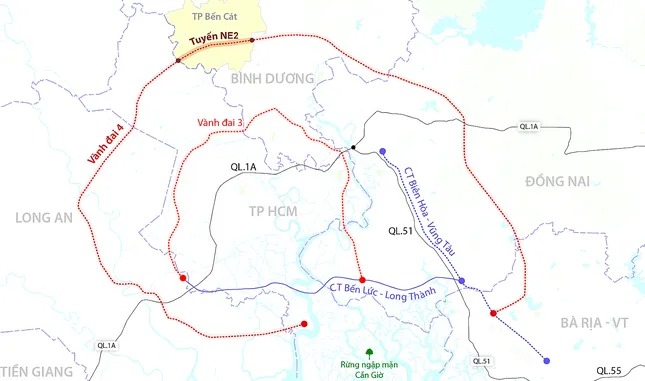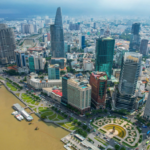
Ho Chi Minh City Ring Road 4 Project Diagram
The National Assembly approved the investment project to build Ho Chi Minh City Ring Road 4 at the 9th session of the 15th National Assembly on the afternoon of June 12th.
According to the report presented by Mr. Tran Hong Minh, Minister of Construction, the project to invest in the construction of Ho Chi Minh City Ring Road 4 is a key national project. The project will be implemented in Ho Chi Minh City and the provinces of Ba Ria-Vung Tau, Dong Nai, Long An, and Binh Duong, as reported by the Government Portal.
The project has a total length of about 207.6 km, with an investment scope of about 159.31 km, divided into 10 component projects.
The starting point of the project is at the Toc Tien – Chau Pha intersection (the intersection with Bien Hoa – Vung Tau Expressway and Provincial Road DT.992) and the endpoint is at the intersection with the North-South road axis in Hiep Phuoc Port, Nha Be district, Ho Chi Minh City.
The investment scale is that of a highway, with phase 1 (the phased stage) featuring a 4-lane highway with a design speed of 100 km/h and a road width of 25.5 m.
The completed investment phase will feature an 8-lane highway. The total width of the road (including the highway and the parallel road) will be 74.5 m.
The project will apply advanced and modern technologies to ensure safety, synchronization, quality, and efficiency. The use of high technology in construction organization is encouraged, as is adaptation to climate change. An automatic non-stop toll collection system will be implemented in operation and exploitation.
Minister of Construction Tran Hong Minh also stated that the preliminary land occupation requirement for the project is about 1,420.70 ha, of which the site clearance area is about 1,415.49 ha, including: 455.71 ha of rice land, 245.16 ha of other agricultural land, 152.21 ha of residential land, 511.33 ha of land with long-term trees, and 5.90 ha of land for production and business. non-agricultural.
The total investment of the project, according to the Government’s preliminary calculation, is VND 120,412.55 billion, including: the state budget capital for the 2021-2025 period is VND 81.94 billion; the state budget capital for the period 2026-2030 is VND 69,698.39 billion; and the capital mobilized by the investor is VND 50,632.22 billion.
In terms of progress, the investment preparation and project implementation will take place from 2025, with the completion and operation of the work expected in 2029. The component projects will be implemented through the public-private partnership (PPP) mode.
The Minister of Construction emphasized the role of the project in regional connectivity and urban development, stating that it will have a significant impact on the socio-economic development of the region. The Ho Chi Minh City Ring Road 4 will serve as a cross-regional axis, passing through the localities of Long An, Binh Duong, Dong Nai, and Ba Ria-Vung Tau, and will act as a high-speed urban belt road for Ho Chi Minh City.
Investing in the completion of Ho Chi Minh City Ring Road 4 is essential to improving the competitiveness of the economy, meeting inter-regional transport needs in the Southeast, Central Highlands, Mekong Delta, and Tay Nguyen regions, and connecting with Cambodia. It will also connect industrial parks, seaports, and international airports, as well as expanding and developing urban areas.
In addition, the investment project to build Ho Chi Minh City Ring Road 4 is expected to bring enormous economic benefits not only to road users but also to a series of socio-economic activities in the areas directly and indirectly affected by the project.
When the road is put into operation, inter-provincial vehicles will no longer have to pass through densely populated areas, significantly reducing travel time, transportation costs, and traffic congestion, while also minimizing environmental pollution in urban areas.
On the morning of June 12th, the National Assembly passed a resolution on the arrangement of administrative units at the provincial level in 2025. Accordingly, Ba Ria-Vung Tau province, Binh Duong province, and Ho Chi Minh City were merged to form a new city called Ho Chi Minh City, with the political and administrative center located in the current Ho Chi Minh City.
Dong Nai province and Binh Phuoc province were merged to form a new province called Dong Nai, with the political and administrative center located in the current Dong Nai province.
Tay Ninh province and Long An province were merged to form a new province called Tay Ninh, with the political and administrative center located in the current Long An province.
Thus, the Ho Chi Minh City Ring Road 4 project will be implemented in Ho Chi Minh City, Dong Nai, and Tay Ninh.
“Legislating Efficiency: The State Capital Management Law”
The Law on State Capital Management and Investment in Enterprises marks a significant step forward in enhancing the efficiency of capital management and utilization. This legislation is designed to foster greater transparency, autonomy, and accountability among businesses, ultimately contributing to their long-term success and sustainability.
“Lawmaker: Merging Provinces is Not Just an Addition of Land and Population, But a Multiplication of GDP”
On the morning of June 12th, the National Assembly officially passed a resolution to rearrange administrative units at the provincial level. As a result, the country will now consist of 34 provinces and cities, a significant reorganization that aims to streamline and enhance administrative efficiency.
“Creating a Robust and Innovative Mechanism for the Development of Haiphong City”
“Today, the National Assembly continued its 9th session, with discussions on a draft resolution on piloting several specific mechanisms and policies for the development of Hai Phong city. The debate was chaired by Vice Chairman of the National Assembly, Nguyen Duc Hai. This resolution aims to establish unique policies that will accelerate the growth and advancement of Hai Phong, a key urban center in Vietnam.”














































